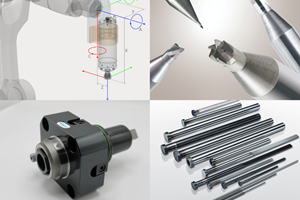Inter-Mold Insert Technology: Can Be Added to Existing Tooling
Hook fields are created in plastic parts by the inter-mold process simultaneously during a standard injection molding cycle (one-shot).
APLIX, Inc. (Charlotte, NC) has developed inter-mold® technology—also referred to as injection molded hook (IMH)—where injection molded hooks are formed directly in plastic parts. Industries currently utilizing the inter-mold process include medical, automotive, cleaning products and sports equipment. This technology is covered by a number of worldwide patents.
Hook fields are created in plastic parts by the inter-mold process simultaneously during a standard injection molding cycle (one-shot). The inter-mold hook shapes are compatible with a wide range of existing loop materials. The process uses fixed and retractable inserts where the hooks temporarily straighten out during the ejection process and then snap back to their original molded shape as the parts cool. In terms of mold design and build, the company specifies the pocket size with tolerances to house the inserts and the ejection required to remove the hook fields. Therefore, the mold designer can ensure that there is nothing that can be damaged (i.e., water lines) when cutting the pockets and design ejection systems accordingly. The mold designer needs to know the specific recommendations to eject the inter-mold hook field so he can take this into consideration when designing the overall part ejection. Compatible resins include polypropylene, polyethylene, nylon, polyurethane, acetal and thermoplastic urethane (TPU).
In most cases, inter-mold can be added to existing tooling. The company’s engineers evaluate current tooling and the desired locations for inter-mold inserts to ensure retrofitting is possible, and they design and manufacture inter-mold inserts. While the company does have relationships with qualified toolmaking companies to assist in tooling solutions, in-house mold shops or local tooling companies also can be used to install the inter-mold inserts. They also will provide any assistance needed including mold drawing review. The inserts can be placed practically anywhere in the tool. In special cases where the draft angle exceeds 45 degrees, inserts would be placed on a retractable slide.
All injection molded parts require some ejection force to remove the part from the mold. Fields of inter-mold affect the ejection behavior of a part due to the series of small undercuts. Standard ejection technology—such as ejector pins, sucker pins and stripper plates—can be used to free the part from the mold. Ejection requirements are part of the design review. The time required to implement inter-mold ranges from six to eight weeks in existing tooling—depending on the shape of inserts and complexity of the mold.
This technology provides the ability to integrally mold hook fields in injection molded parts—eliminating the need to use an adhesive-backed hook fastener and the labor to apply the hook to the part. Additionally, the process is environmentally friendly due to the elimination of glues and adhesives, and the parts are more aesthetically appealing as the hook fields are now designed in.
“We use inter-mold technology to change an existing tool to mold hook directly onto our specialty cervical collar. This enabled us to eliminate applying multiple pressure sensitive adhesive hook pieces as a secondary operation. It was cost effective and improved product appearance,” states Mr. Anthony H. Martinez, VP of Jerome Medical, a company making specialty medical devices based in New Jersey.
Related Content
Tips for Tackling Mold Design, Machining, Cutting Tool and Wear Challenges
Tips for tasks ranging from reducing risk in part design and taking advantage of five-axis machining to refining cutting tool performance and reducing wear with guiding and centering systems.
Read MoreBuilding Molds: Most Popular Reads of 2024
Dive into the most-viewed content for building your mold, including topics such as cutting tools, EDM, hot runners, additive manufacturing, mold materials, machining and mold components.
Read MoreTechnology Roundup: New/Improved Technologies You Don't Want to Miss
With all the technology joining the market, moldmaking is a versatile, ever-evolving industry. As such, this technology roundup has no specific theme — it features a variety of products for applications and solutions across the industry.
Read MoreWhy Shoulder Bolts Are Too Important to Ignore (Part 1)
These humble but essential fasteners used in injection molds are known by various names and used for a number of purposes.
Read MoreRead Next
Are You a Moldmaker Considering 3D Printing? Consider the 3D Printing Workshop at NPE2024
Presentations will cover 3D printing for mold tooling, material innovation, product development, bridge production and full-scale, high-volume additive manufacturing.
Read MoreHow to Use Strategic Planning Tools, Data to Manage the Human Side of Business
Q&A with Marion Wells, MMT EAB member and founder of Human Asset Management.
Read More


















